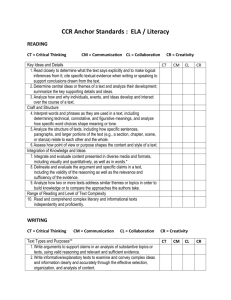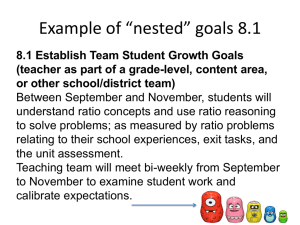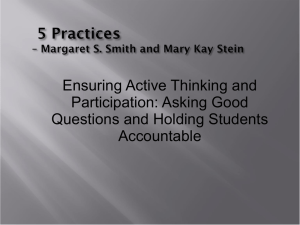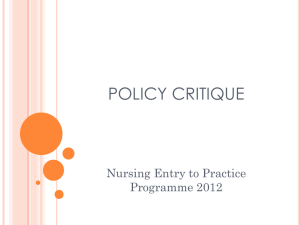Fourth Grade English Language Arts, Ver. 2.0
advertisement
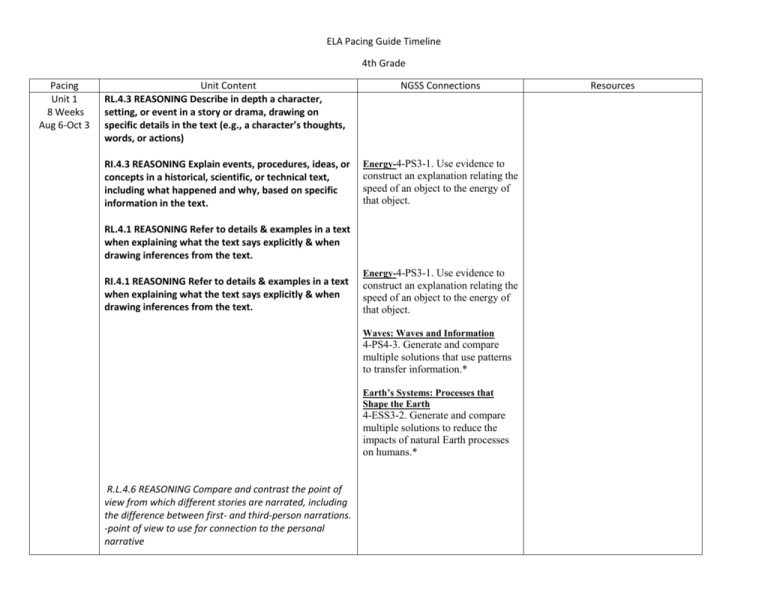
ELA Pacing Guide Timeline 4th Grade Pacing Unit 1 8 Weeks Aug 6-Oct 3 Unit Content RL.4.3 REASONING Describe in depth a character, setting, or event in a story or drama, drawing on specific details in the text (e.g., a character’s thoughts, words, or actions) RI.4.3 REASONING Explain events, procedures, ideas, or concepts in a historical, scientific, or technical text, including what happened and why, based on specific information in the text. NGSS Connections Energy-4-PS3-1. Use evidence to construct an explanation relating the speed of an object to the energy of that object. RL.4.1 REASONING Refer to details & examples in a text when explaining what the text says explicitly & when drawing inferences from the text. RI.4.1 REASONING Refer to details & examples in a text when explaining what the text says explicitly & when drawing inferences from the text. Energy-4-PS3-1. Use evidence to construct an explanation relating the speed of an object to the energy of that object. Waves: Waves and Information 4-PS4-3. Generate and compare multiple solutions that use patterns to transfer information.* Earth’s Systems: Processes that Shape the Earth 4-ESS3-2. Generate and compare multiple solutions to reduce the impacts of natural Earth processes on humans.* R.L.4.6 REASONING Compare and contrast the point of view from which different stories are narrated, including the difference between first- and third-person narrations. -point of view to use for connection to the personal narrative Resources RI.4.6 Craft and Structure: REASONING Compare and contrast a firsthand and secondhand account of the same event or topic; describe the differences in focus and the information provided. -first and secondhand account of the same event RL.4.10* RI.4.10* L.4.1 a,b,d,f PERFORMANCE SKILL Demonstrate command of the conventions of standard English grammar and usage when writing or speaking. a. Use relative pronouns (who, whose, whom, which, that) and relative adverbs (where, when, why). b. Form and use the progressive (e.g., I was walking; I am walking; I will be walking) verb tenses. d. Order adjectives within sentences according to conventional patterns (e.g., a small red bag rather than a red small bag). f. Produce complete sentences, recognizing and correcting inappropriate fragments and run-ons. L.4.2a, d KNOWLEDGE Demonstrate command of the conventions of standard English capitalization, punctuation, and spelling when writing. a. Use correct capitalization. d. Spell grade-appropriate words correctly, consulting references as needed. L.4.5a REASONING Demonstrate understanding of figurative language, word relationships, & nuances in word meanings. a. Explain the meaning of simple similes and metaphors (e.g. as pretty as a picture) in context. L.4.3b PERFORMANCE SKILL Use knowledge of language and its conventions when writing, speaking, reading, or listening. b. Choose punctuation for effect. W. 4.3. PRODUCT Write narratives to develop real or imagined experiences or events using effective technique, descriptive details, and clear event sequences. a. Orient the reader by establishing a situation and introducing a narrator and/or characters; organize an event sequence that unfolds naturally. b. Use dialogue and description to develop experiences and events or show the responses of characters to situations. c. Use a variety of transitional words and phrases to manage the sequence of events. d. Use concrete words and phrases and sensory details to convey experiences and events precisely. e. Provide a conclusion that follows from the narrated experiences or events. Unit 2 9 Weeks Oct 13-Dec 19 W.4.4* W.4.5* W.4.6* W.4.10* RI.4.5 Craft and Structure: KNOWLEDGE Describe the overall structure (e.g., chronology, comparison, cause/effect, problem/solution) of events, ideas, concepts, or information in a text or part of a text. RL.4.4 REASONING Determine the meaning of words and phrases as they are used in a text, including those that allude to significant characters found in mythology (e.g. Herculean strength). RI.4.4 REASONING Determine the meaning of general academic and domain-specific words and phrases in a text relevant to a grade 4 topic of subject area. RI.4.8 REASONING Explain how an author uses reasons and evidence to support particular points in a text. RL.4.10* RI.4.10* L.4.3a,c. PERFORMANCE SKILL Use knowledge of language and its conventions when writing, speaking, reading, or listening. a.Choose words and phrases to convey ideas precisely. c. Differentiate between contexts that call for formal English (e.g., small-group discussion). L.4.2 b, c KNOWLEDGE Demonstrate command of the conventions of standard English capitalization, punctuation, and spelling when writing. a. Use correct capitalization. b. Use commas and quotation marks to mark direct speech and quotations from a text. L.4.4a,b,c REASONING Determine or clarify the meaning of unknown and multiple-meaning words and phrases based on grade 4 reading and content, choosing flexibly from a range of strategies. a. Use context (e.g., definitions, examples, or restatements in text) as a clue to the meaning of a word or phrase. b. Use common, grade-appropriate Greek and Latin affixes and roots as clues to the meaning of a word (e.g., telegraph, photograph, autograph). c. Consult reference materials (e.g., dictionaries, glossaries, thesauruses), both print and digital, to find the pronunciation and determine or clarify the precise meaning of key words and phrases. W.4.1 PRODUCT Write opinion pieces on topics or texts, supporting a point of view with reasons and information. a. Introduce a topic or text clearly, state an opinion, and create an organizational structure in which related ideas are grouped to support the writer’s purpose. b. Provide reasons that are supported by facts and details. c. Link opinion and reasons using words and phrases (e.g., for instance, in order to, in addition). d. Provide a concluding statement or section related to the opinion presented. W.4.9b REASONING Draw evidence from literary or informational texts to support analysis, reflection, and research. b. Apply grade 4 reading standards to informational texts . (e.g. Explain how an author uses…) 4-Energy PS3-1. Use evidence to construct an explanation relating the speed of an object to the energy of that object. 4-Energy ESS3-1. Obtain and combine information to describe that energy and fuels are derived from natural resources and their uses affect the environment. 4 -Earth’s Systems: Processes that Shape the Earth 4-ESS1-1. Identify evidence from patterns in rock formations and fossils in rock layers to support an explanation for changes in a landscape over time. W.4.4* W.4.5* W.4.6* W.4.10* Unit 3 RL.4.2 REASONING 8 Weeks Determine a theme of a story drama, or poem from Jan 6 –Feb 27 details in the text; summarize the text. RI.4.2 REASONING Determine the main idea of a text & explain how it is supported by key details; summarize the text. RL.4.5 Craft and Structure: KNOWLEDGE Explain major differences between poems, drama, and prose, and refer to the structural elements of poems (e.g., verse, rhythm, meter) and drama (e.g., casts of characters, setting descriptions, dialogue, stage directions) when writing or speaking about a text. RL.4.7 REASONING Make connections between the text of a story or drama and a visual or oral presentation of the text, identifying where each version reflects specific descriptions and directions in the text. RL.4.10* RI.4.10* L.4.5 a, b, c REASONING Demonstrate understanding of figurative language, word relationships, & nuances in word meanings. a. Explain the meaning of simple similes and metaphors (e.g. as pretty as a picture) in context. b. Recognize and explain the meaning of common idioms, adages, and proverbs. c. Demonstrate understanding of words by relating them to their opposites (antonyms) and to words with similar but not identical meanings (synonyms). L.4.1 c, e, g. PERFORMANCE SKILL Demonstrate command of the conventions of standard English grammar and usage when writing or speaking. c. Use modal auxiliaries (e.g., can, may, must) to convey various conditions. a red small bag). e. Form and use prepositional phrases. g. Correctly use frequently confused words (e.g., to, too, two; there, their). W.4.9a REASONING Draw evidence from literary or informational texts to support analysis, reflection, and research. a.Apply grade 4 reading standards to literature. (e.g. Describe in depth…) 4- Energy PS3-1. Use evidence to construct an explanation relating the speed of an object to the energy of that object. 4- Energy ESS3-1. Obtain and combine information to describe that energy and fuels are derived from natural resources and their uses affect the environment. 4 Earth’s Systems: Processes that Shape the Earth 4-ESS1-1. Identify evidence from patterns in rock formations and fossils in rock layers to support an explanation for changes in a landscape over time. W.4.4* W.4.5* W.4.6* W.4.10* Unit 4 8 Weeks March 2- RL. 4.6 REASONING Compare and contrast the point of view from which different stories are narrated, including the difference April 30 between first- and third-person narrations RI.4.6 Craft and Structure: REASONING Compare and contrast a firsthand and secondhand account of the same event or topic; describe the differences in focus and the information provided. RL.4.9-REASONING Compare and contrast the treatment of similar themes and topics (e.g., opposition of good and evil) and patterns of events (e.g., the quest) in stories, myths, and traditional literature from different cultures. RI.4.9- REASONING Integrate information from two texts on the same topic in order to write or speak about the subject knowledgeably. 4-Energy PS3-1. Use evidence to construct an explanation relating the speed of an object to the energy of that object. 4-Waves: Waves and Information 4-PS4-3. Generate and compare multiple solutions that use patterns to transfer information.* 4.Earth’s Systems: Processes that Shape the Earth 4-ESS3-2. Generate and compare multiple solutions to reduce the impacts of natural Earth processes on humans.* RL.4.10* RI.4.10* L.4.6- REASONING Acquire and use accurately grade-appropriate general academic and domain-specific words and phrases, including those that signal precise actions, emotions, or states of being (e.g. quizzed, whined, stammered) and that are basic to a particular topic (e.g. wildlife, conservation, and endangered when discussing animal preservation. W.4.2-Informative/explanatory PRODUCT Write informative/explanatory texts to examine a topic and convey ideas and information clearly (a, b, c, d, and e). a.Introduce a topic clearly and group related information in paragraphs and sections; including formatting (e.g. Headings), illustrations, and multimedia when useful to aiding comprehension. b.Develop the topic with facts, definitions, concrete details, quotations, or other information and examples related to the topic. c.Link ideas within categories of information using words and phrases (e.g., another, for example, also, because.) d.Use precise language and domain-specific vocabulary to inform about or explain the topic. e. Provide a concluding statement or section related to the information or explanation presented 4.Energy W.4.8-Research to Build and Present Knowledge: 4.Energy REASONING Recall relevant information from experiences or gather relevant information from print and digital sources; take notes and categorize information, and provide a list of sources 4-PS3-1. Use evidence to construct an explanation relating the speed of an object to the energy of that object. 4-PS3-1. Use evidence to construct an explanation relating the speed of an object to the energy of that object. 4.Energy 4-PS3-2. Make observations to provide evidence that energy can be transferred from place to place by sound, light, heat, and electric currents. 4.Energy 4-PS3-3. Ask questions and predict outcomes about the changes in energy that occur when objects collide. 4.Energy 4-PS3-4. Apply scientific ideas to design, test, and refine a device that converts energy from one form to another.* 4.Energy 4-ESS3-1. Obtain and combine information to describe that energy and fuels are derived from natural resources and their uses affect the environment. 4.Earth’s Systems: Processes that Shape the Earth 4-ESS1-1. Identify evidence from patterns in rock formations and fossils in rock layers to support an explanation for changes in a landscape over time. 4.Earth’s Systems: Processes that Shape the Earth 4-ESS2-1. Make observations and/or measurements to provide evidence of the effects of weathering or the rate of erosion by water, ice, wind, or vegetation. W.4.7- REASONING Conduct short research projects that build knowledge through investigation of different aspects of a topic. 4.Energy 4-PS3-2. Make observations to provide evidence that energy can be transferred from place to place by sound, light, heat, and electric currents. 4.Energy 4-PS3-3. Ask questions and predict outcomes about the changes in energy that occur when objects collide. 4.Energy 4-PS3-4. Apply scientific ideas to design, test, and refine a device that converts energy from one form to another.* 4.Energy 4-ESS3-1. Obtain and combine information to describe that energy and fuels are derived from natural resources and their uses affect the environment. 4.Earth’s Systems: Processes that Shape the Earth 4-ESS1-1. Identify evidence from patterns in rock formations and fossils in rock layers to support an explanation for changes in a landscape over time. 4.Earth’s Systems: Processes that Shape the Earth 4-ESS2-1. Make observations and/or measurements to provide evidence of the effects of weathering or the rate of erosion by water, ice, wind, or vegetation. W.4.4* W.4.5* W.4.6* W.4.10* Unit 5 May Standards Review RL.4.10* REASONING By the end of the year, read and comprehend literature, including stories, dramas, and poetry, in the grades4–5 text complexity band proficiently, with scaffolding as needed at the high end of the range. RI.4.10* REASONING By the end of the year; read and comprehend informational texts, including history/social studies, science, and technical texts, in the grades 4-5 text complexity band proficiently, with scaffolding as needed at the high end of the range. W.4.4* Production and Distribution of Writing: PRODUCT Produce clear and coherent writing in which the development and organization are appropriate to task, purpose, and audience. (Grade-specific expectations for writing types are defined in standards 1–3 above.) W.4.5* REASONING With guidance and support from peers and adults, develop and strengthen writing as needed by planning, revising editing, rewriting, or trying a new approach. (Editing for conventions should demonstrate command of Language standards 1-3 up to and including grade 4 on pages 28 and 29.) W.4.6* Production and Distribution of Writing: PERFORMANCE SKILL With some guidance and support from adults, use technology, including the Internet, to produce and publish writing as well as to interact and collaborate with others; demonstrate sufficient command of keyboarding skills to type a minimum of one page in a single sitting. W.4.10* PERFORMANCE SKILL Write routinely over extended time frames (time for research, reflection, and revision) and shorter time frames (a single sitting or a day or two) for a range of discipline-specific tasks, purposes, and audiences.



